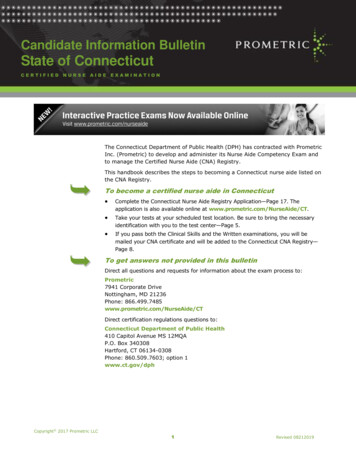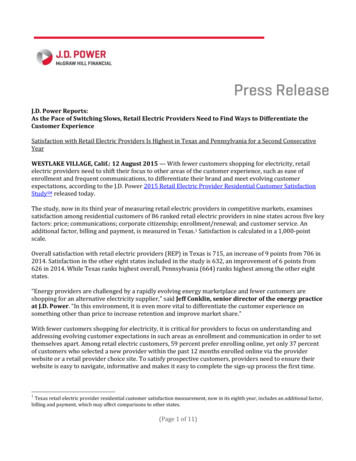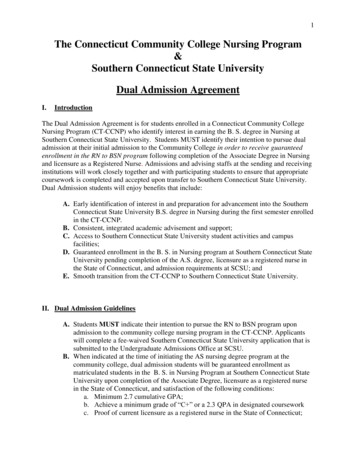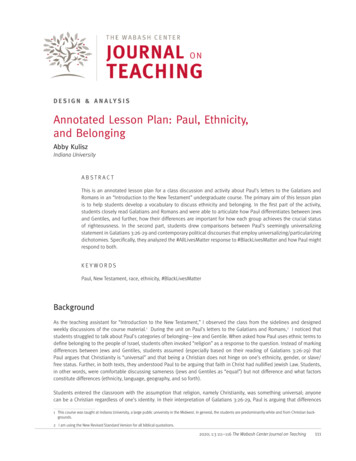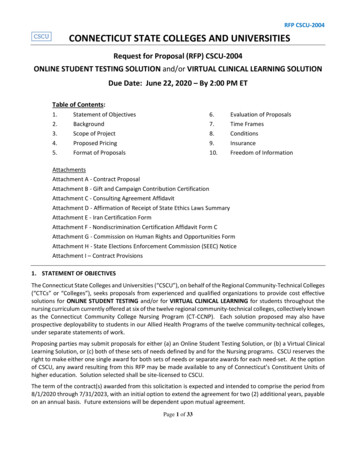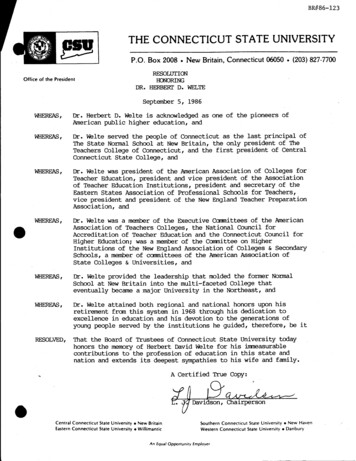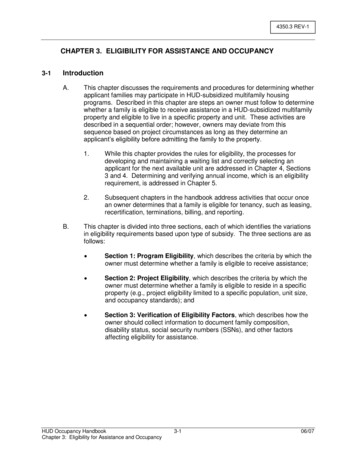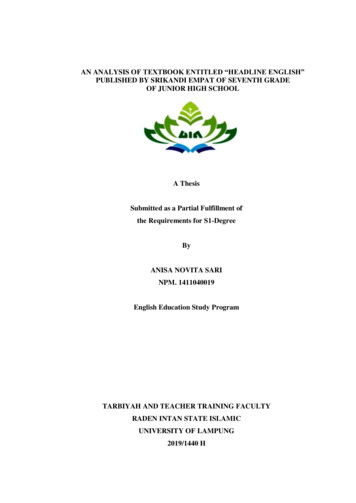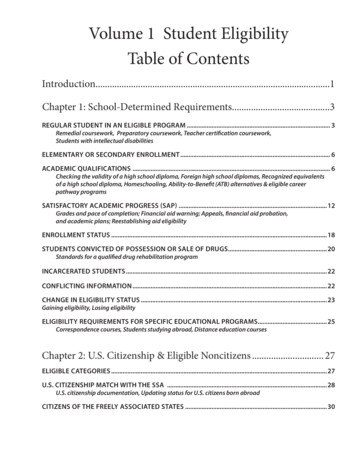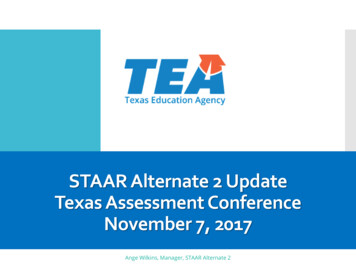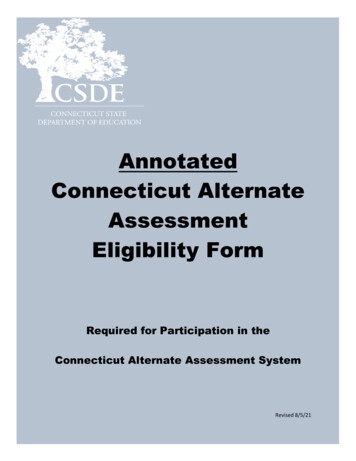
Transcription
AnnotatedConnecticut AlternateAssessmentEligibility FormRequired for Participation in theConnecticut Alternate Assessment SystemRevised 8/5/21
Connecticut Alternate Assessment (CTAA & CTAS) Eligibility FormSTUDENT NAME:SASID:Is the student identified as an English Learner in the Public School Information System (PSIS)?YesNoStudents with significant cognitive disabilities considered eligible for an alternate assessment may also be duallyidentified as English Learners in the Public School Information System. This additional identification is importantsince these students also participate in an annual English Language Proficiency Assessment in Grades K-12.Please indicate the student’s Primary Disability as evidenced by the most recent Individualized Education Plan (IEP):AutismDeaf/BlindnessDevelopmental DelayEmotional Disturbance*Hearing ImpairmentIntellectual DisabilityMultiple DisabilitiesOrthopedic ImpairmentOther Health Impairment or OHI - ADD/ADHDSpecific Learning Disability* or SLD/Dyslexia*Traumatic Brain InjurySpeech/Language ImpairmentVisual Impairment*Please note: Specific Learning Disability, SLD/Dyslexia and Emotional Disturbance – Sections 34 CFR 300.309 (3)(a)(1) and (2)and 300.8(c)(4)(i) of the IDEA require that intellectual factors/impairments be ruled out in order to qualify for special educationservices under the categories of a specific learning disability or emotional disturbance. Therefore, students with these primarydisability types would not typically qualify to participate in the CTAA or CTAS.Generally, the following primary disability categories, based upon data review, are more likely to have apreponderance of evidence supporting participation in the Alternate Assessment System: Autism, IntellectualDisability, Multiple Disabilities, or Traumatic Brain Injury. Other primary disability categories require additionalevidence to support participation in an alternate assessment. This additional evidence should demonstrate accessbarriers to the standard summative assessments regardless of designated supports, accommodations, andassistive technology.The student must meet all of the numbered criteria outlined below to participate in Connecticut AlternateAssessments.This student has a significant cognitive disability, as evidenced by:1.Student has an intellectual impairment.A. No evidence exists to support that this student has an intellectual impairment.STOP: student is not eligible to participate in the alternate assessment system.If the Planning and Placement Team (PPT) determines there is insufficient evidence to support theintellectual impairment for the student, then the PPT should select the appropriate grade-levelstandard assessments with designated supports, accommodations, and assistive technology (ifapplicable) to meet the student’s access needs. The Alternate Assessment Eligibility Form should notbe entered into the Data Entry Interface by the Trained Teacher Administering the Alternate (TEA).However, the draft form (with associated PPT notes) should be maintained with the PPT documentationas evidence of the discussion.B. In the absence of standardized, cognitive assessments/scores, there is evidence to substantiate thepresence of an intellectual impairment.When a student has significant communication, sensory, or motor limitations that preclude certain forms of testpresentation or responses, the PPT should discuss and document the steps taken to determine the bestalternative to a standardized cognitive assessment. The PPT may consider requesting additional testing. The PPTmust determine and provide evidence documenting an intellectual impairment and why the student is not ableto access the standard summative assessments, even when provided designated supports and accommodations.Annotated Connecticut Alternate Assessment Eligibility FormRevised 8/5/21Page 2 of 6
ORC.Results of cognitive testing (e.g., Full-Scale IQ score 70): Assessment Used: (Choose from the drop-down menu)o Cognitive Assessment System (CAS)o Comprehensive Test of Nonverbal Intelligence (CTONI)oDifferential Ability Scales (DAS)oKaufman Assessment Battery for Children (KABC)oNaglieri Nonverbal Ability Test (NNAT)ooPictorial Test of Intelligence (PTI)Reynolds Intellectual Assessment Scales (RIAS)oStanford-Binet Intelligence Scale (SB)oTest of Nonverbal Intelligence (TONI)oUniversal Nonverbal Intelligence Test (UNIT)ooWechsler Adult Intelligence Scale (WAIS)Wechsler Intelligence Scale for Children (WISC)oWechsler Intelligence Scale for Children SpanishoWechsler Nonverbal Scale of Ability (WNV)oWechsler Preschool & Primary Scale of Intelligence (WPPSI)oWoodcock-Johnson Test of Cognitive Abilities (WJ)oOther (Specify):Select the name of the cognitive assessment used to provide evidence of an intellectual impairment from themenu provided. (As referenced in the American Psychological Association’s Ethical Principles of Psychologistsand Code of Conduct, Section 9: Assessments, these assessments should be the most current editionavailable).If “Other“ is selected DO NOT use assessments or associated composite scores that do not measure broadcognitive functioning for the purpose of this alternate assessment eligibility criteria. (e.g., Adaptive BehaviorScales, Assessment of Basic Language and Learning, Comprehensive Test of Phonological Processing, filereviews, or observations).If “Other” is selected, specify the full name of the cognitive assessment, recognizing these will be identifiedfor additional CSDE monitoring.Ensure that the evaluations address the degree for which a student’s second language acquisition affectsvalidity and reliability of test findings for students who are English learners (ELs). Date Completed: (mm/dd/yyyy)Include the month, day, and year for which the cognitive assessment was completed. This date should be within3 years of the PPT’s discussion about the participation in the alternate assessment for the current school year. Ifthe date spans more than 3 years, it is recommended that the PPT determine an appropriate measure to assessthe student’s current cognitive functioning. Composite Name: Composite Score:Annotated Connecticut Alternate Assessment Eligibility FormRevised 8/5/21Page 3 of 6
2.Student has adaptive behavior skills well below age-level expectations.Adaptive behavior is defined as those conceptual, social, and practical skills necessary to meet the commondemands of everyday life across multiple settings.A. Student has adaptive behaviors necessary for the student to live independently and function safely in dailylife for their age group (34 CFR §§ 200.1(d) and 300.160 (c)).STOP: student is not eligible to participate in the alternate assessment system.If the PPT determines there is insufficient evidence defining the student’s need for support in the area of adaptivebehavior skills, then the PPT should select the appropriate grade-level standard assessments with designatedsupports, accommodations, and assistive technology (if applicable) to meet the student’s access needs. TheAlternate Assessment Eligibility Form should not be entered into the Data Entry Interface by the Trained TEA.However, the draft form (with associated PPT notes) should be maintained with the PPT documentation asevidence of the discussion.B. Results of adaptive behavior assessment(s) (e.g., scored more than 1.5 standard deviations below the meanscore); Assessment Used: (Choose from the drop-down menu)o Adaptive Behavior Assessment System (ABAS)o Scales of Independent Behavior-Revised (SIB-R)oVineland Adaptive Behavior Scales (VABS)oOther (Specify):Select name of the adaptive assessment used to provide evidence of insufficient adaptive behavior skills fromthe provided menu. (As referenced in the American Psychological Association’s Ethical Principles ofPsychologists and Code of Conduct, Section 9: Assessments, these assessments should be the most currentedition available).If “Other“ is selected, DO NOT use assessments or associated composite scores that do not measure broadadaptive behavior skills for the purpose of this alternate assessment eligibility criteria. (e.g., Assessment ofBasic Language and Learning, Autism Behavior Rating Scale, Autistic Diagnostic Observation Schedule,Behavior Assessment System for Children, file review, or observations).If “Other” is selected, specify the full name of the adaptive behavior skill assessment, recognizing these willbe identified for additional CSDE monitoring.Ensure that the evaluations address the degree for which a student’s second language acquisition affects thevalidity and reliability of test findings for students who are ELs. Date Completed: (mm/dd/yyyy)Include the month, day, and year for which the adaptive assessment was completed. This date should be within3 years of the PPT’s discussion about the participation in the alternate assessment for the current school year. Ifthe date spans more than 3 years, it is recommended that the PPT determine an appropriate measure to assessthe student’s current adaptive behavioral skills. Composite/Functional Level:Enter the numerical adaptive behavior composite score from the standardized adaptive behavior skill assessmentadministered. Typically, this score must be more than 1.5 standard deviations below the mean score for a studentto meet this component of the criterion for eligibilityAnnotated Connecticut Alternate Assessment Eligibility FormRevised 8/5/21Page 4 of 6
3.Student requires intensive instruction and significant supports.A. Student does not require extensive, repeated, individualized instruction.STOP: student is not eligible to participate in the alternate assessment system.If the PPT determines there is insufficient evidence defining the student’s need for intensive instruction withsignificant supports, then the PPT should select the appropriate grade-level standard assessments with designatedsupports, accommodations, and assistive technology (if applicable) to meet the student’s access needs. TheAlternate Assessment Eligibility Form should not be entered into the Data Entry Interface by the Trained TEA.However, the draft form (with associated PPT notes) should be maintained with the PPT documentation asevidence of the discussion.B. Student requires extensive, repeated instruction and support that is not of a temporary or transient nature,and uses substantially adapted materials and individualized methods of accessing information in alternativeways to acquire, maintain, demonstrate, and transfer skills.The PPT is able to provide evidence that the student has IEP goals and objectives linked to (and derived from) theConnecticut Core Standards (CCS) and Next Generation Science Standards (NGSS), which are the academicstandards for English language arts, mathematics, and science in Connecticut. To access these standards, studentsare typically provided repeated access to content in a systematic manner, across multiple settings and subjectareas, allowing these students greater opportunity to demonstrate what they know and can do. Supports areindividualized and evidenced throughout the student’s IEP, particularly in the student’s present levels ofperformance, goals and objectives, accommodations, and related service needs. Students who do not requireextensive, repeated, and individualized instruction, and do not use substantial supports to achieve measureablegains in the grade- and age-appropriate curricula, are expected to take Connecticut’s standard assessments withdesignated supports, accommodations, and assistive technology (if applicable) as indicated in the student’s IEP.Annotated Connecticut Alternate Assessment Eligibility FormRevised 8/5/21Page 5 of 6
Connecticut Alternate AssessmentEligibility FormVERIFICATION SECTION1. I verify that supporting evidence related to the student’s assessment options was discussed at the Planningand Placement Team (PPT) on (mm/dd/yyyy, date of PPT) to determine eligibility forparticipation in Connecticut Alternate Assessments.2. Evidence reviewed during the PPT was used to determine that the student meets all three evidence-basedcriteria for participation in Connecticut Alternate Assessments:a) Student has an intellectual impairment with supporting evidence per cognitive testing or otherdetails/evidence exist to substantiate the existence of an intellectual impairment.b) Student’s adaptive behavior skills are well below age-level expectations with supporting evidence peradaptive behavior assessment(s) (e.g., scored more than 1.5 standard deviations below the meanscore).c) Student requires intensive instruction and significant supports.This student is eligible for and will participate in Connecticut Alternate Assessments during the currentschool year as indicated in the assessment areas of their Individualized Education Program (IEP). TheConnecticut Alternate Assessment Eligibility Form must be submitted through the Data Entry Interface bythe appropriate due date each year when the student is in Grades 3-8 and 11.Note: If the student does not meet all three evidence-based criteria for participation in Alternate Assessmentsas indicated above, the student will participate in the standard statewide assessments with designatedsupports, accommodations, and assistive technology (if applicable) as indicated throughout their IEP.The TEA will use the PPT-approved Alternate Assessment Eligibility Form to submit the evidence in the DataEntry Interface by the due date established. If the student does not have supporting evidence to participatein the Alternate Assessment System, the draft Alternate Assessment Eligibility Form and associated discussionnotes should be maintained with the PPT documents. A student who is determined ineligible for the AlternateAssessment System should participate in the appropriate standard assessments with designated supports,accommodations, and assistive technology as needed. The draft Alternate Assessment Eligibility Form (withassociated PPT notes) should be maintained with the PPT documentation as evidence of the discussion.Note: Once this form is completed and approved by the Planning and Placement Team, please provide a copyto the Director of Special Education, the District Administrator for testing, and the District English LearnerAssessment Coordinator if the student is also identified as an English learner.Primary Special Education Teacher/TEAPrinted Name:(Please Print)Signature:Telephone NumberEIN:10-digit Educator ID NumberDateNote: TEAs do not need to provide their EIN on this paper form but when submitting this form in the Data EntryInterface to register the student to participate in the Alternate Assessment System, the TEA will include their EIN.This form represents a critical data point to ensure students participate in the most appropriate assessment and arereflected accurately in all systems managed by the Connecticut State Department of Education. For students determinedeligible to participate in the Alternate Assessment System by the PPT, providing a copy of this form to the Director ofSpecial Education, the District Administrator (DA in TIDE) and the District English Learner Assessment Coordinator allowsthe planning for each of the assessment programs to be facilitated more effectively.Annotated Connecticut Alternate Assessment Eligibility FormRevised 8/5/21Page 6 of 6
o Wechsler Nonverbal Scale of Ability (WNV) o Wechsler Preschool & Primary Scale of Intelligence (WPPSI) o Woodcock-Johnson Test of Cognitive Abilities (WJ) o Other (Specify): _ Select the name of the cognitive assessment used to provide evidence of an intellectual impairment f
